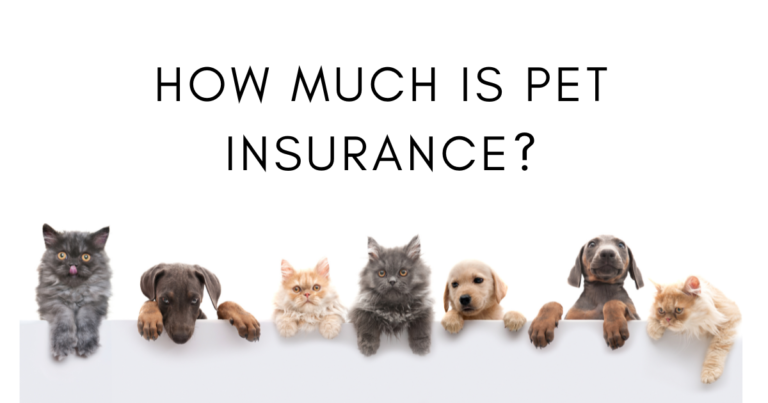Taking care of your furry friend is a top priority, and pet insurance is a great way to ensure they receive the best care when it matters most. But as a pet owner, you’re probably asking yourself, “How Much is Pet Insurance actually cost?” This guide dives into the factors that influence pet insurance prices, helps you understand what to expect, and answers common questions to help you make an informed decision.
Table of Contents
What Determines the Cost of Pet Insurance?
The cost of pet insurance varies significantly depending on several factors. Here are the main aspects that insurance providers consider when determining your premium:
1. Type of Pet
Dogs and cats are the most commonly insured pets, but prices differ based on species. Dog insurance tends to cost more than cat insurance due to their higher likelihood of health issues and accidents.
2. Breed
Certain breeds are more prone to hereditary conditions. For example, large dog breeds such as Golden Retrievers may have a higher risk of hip dysplasia, while Persian cats are more likely to experience respiratory issues. Insurance providers factor these risks into their pricing.
3. Age
Older pets are more likely to develop health problems, leading to higher premiums. Insuring your pet while they’re young can help lock in lower monthly costs.
4. Location
Where you live impacts the cost of veterinary care. Pet insurance is typically more expensive in urban areas due to higher vet fees compared to rural regions.
5. Coverage Type
The type of policy you choose plays a significant role in the cost. Basic accident-only plans are more affordable than comprehensive policies that cover accidents, illnesses, preventative care, and specialized treatments.
6. Deductibles, Reimbursement Rates, and Annual Limits
- Deductibles: Higher deductibles mean lower monthly premiums but require you to pay more out-of-pocket per claim.
- Reimbursement Rates: Choosing a higher reimbursement percentage (e.g., 90%) increases premiums while covering more of your vet bills.
- Annual Limits: Plans with higher annual payout limits cost more than those with lower limits.
Average Costs of Insurance
Here’s a breakdown of typical pet insurance costs based on different factors:
| Plan Type | Dogs (Monthly) | Cats (Monthly) | Key Details |
|---|---|---|---|
| Accident-Only | $15–$25 | $10–$20 | Covers accidents like broken bones |
| Accident & Illness | $25–$70 | $15–$40 | Includes accidents and illnesses |
| Comprehensive | $50–$100+ | $30–$80 | Covers accidents, illnesses, and wellness care |
The prices above are averages and can vary based on individual circumstances, such as breed, age, and location.
Is Insurance Worth It?
Pet insurance can provide peace of mind and financial security. Consider this scenario: if your dog needs surgery for a torn ligament costing $3,000, a comprehensive plan with 90% reimbursement saves you $2,700.
Without insurance, these unexpected expenses can put a strain on your finances. Knowing your pet’s medical bills are covered allows you to focus on their recovery rather than the cost.
Frequently Asked Questions About How Much is Pet Insurance
1. What does pet insurance typically cover?
Most pet insurance plans cover unexpected events like accidents and illnesses. Comprehensive plans may also include routine care, vaccinations, and dental cleanings. Be sure to check the policy details for any exclusions.
2. Does pet insurance cover pre-existing conditions?
No, most pet insurance providers do not cover pre-existing conditions. However, some plans may cover curable pre-existing conditions after a specified waiting period.
3. How can I save money on insurance?
- Insure your pet while they’re young to lock in lower rates.
- Compare plans from different providers to find the best deal.
- Opt for higher deductibles or lower reimbursement rates to reduce premiums.
4. Are there any waiting periods for coverage?
Yes, most pet insurance companies have waiting periods before coverage starts. This typically ranges from 14–30 days for illnesses and may be shorter for accidents.
5. Can I choose any vet with insurance?
Most pet insurance providers allow you to visit any licensed veterinarian, including specialists. However, it’s always recommended to confirm this with your insurance provider.
6. Is insurance tax-deductible?
Pet insurance is generally not tax-deductible unless your pet is a service animal. Check with a tax professional for specifics in your location.
Making the Right Choice for Your Pet’s Health
Choosing pet insurance is a personal decision, but it’s one that can save you from significant financial headaches down the line. By understanding the costs, coverage options, and potential benefits, you’re in a position to decide what’s best for your furry friend.
Before you choose a plan, take the time to compare different providers, read the fine print, and consider your pet’s specific needs. Many providers offer instant quotes online, making it easy to explore your options.
